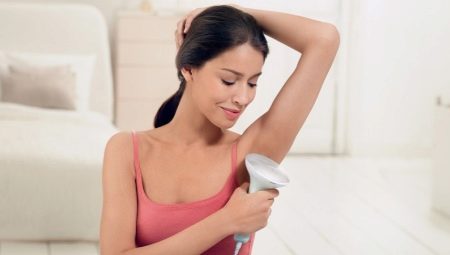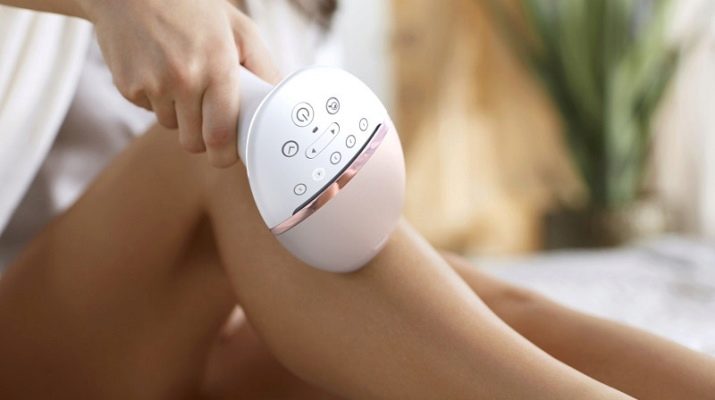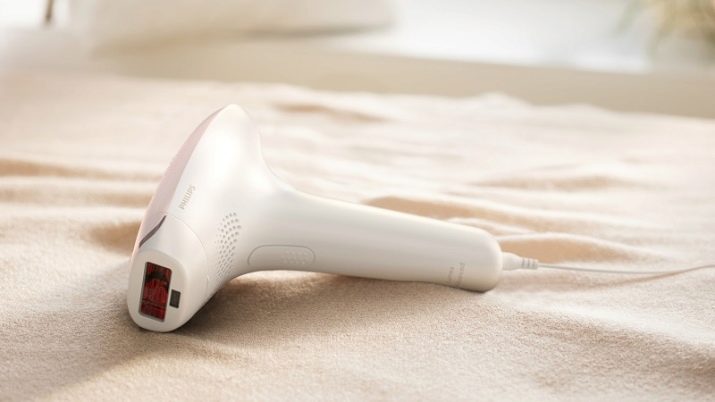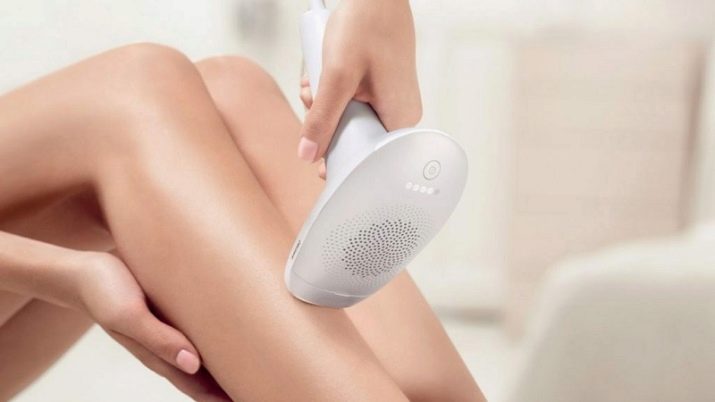Photoepilation at home

Home hair removal is one of the ways to get rid of excess hair on the body. This option is suitable for those who cannot get to the salon, or prefers home care to all cosmetic and beauty salon procedures. The demand for such services is only growing, and therefore the method is being modernized and becoming more and more adapted for home use.

What it is?
Both laser hair removal and photoepilation operate according to similar principles - it consists in the action of light waves. A ray of light striking the hair causes it to detach from the follicle and fall out. Or rather, to fall away. The laser also kills the bulb, so further hair growth is excluded. But there are still differences between these procedures.
Photoepilation has its own characteristics.
- The spectrum of the device corresponds to the interval from 560 to 1200 nm... In the operation of such a device, several lasers are organized at once, and they can remove hair of any shade, with the exception of gray, and from any skin.
- The photoepilator is unable to remove all hairs in one or another part of the body in one session... This is due to the operation of the laser. Therefore, there will be twice as many procedures that completely resolve the issue of excess vegetation compared to laser hair removal.
- The radius of the epilator increases, because more light emitting elements are used. In one session, the device will cover a larger area of the skin.
- Session time is shortening, if you compare the photoepilator with a laser device. And it is reduced by 2, and in some cases, 3 times.
Photoepilation as a procedure is more expensive than laser hair removal.Convenience, speed, painlessness, efficiency - this is what people who want to solve such intimate issues at home pay for.
The main disadvantage of this method is the high cost of the photoepilator.... But everything is comparative: initially, the price may seem high, but if you imagine how many sessions are to be done, and the fact that someone else can use the device later, the cost does not seem to be exorbitant. In addition, those who, for whatever reason, do not want to do the same in the salon, are engaged in photoepilation at home.

Indications and contraindications
A photoepilator is a special lamp that emits photo flashes that negatively affect melanin, the pigment responsible for hair color. Light streams have waves, and they make light energy heat. The hair follicle disintegrates, which then falls out, and the vessels feeding it, one might say, are sealed. That is the most effective photoepilation will be for light skin and dark hair growing on them... Therefore, people with just such indications are considered the best candidates for using photoepilation.
Light and gray hair are much less susceptible to the action of the device., because there is very little melanin in them. In any case, one procedure will definitely not be enough. In some cases, 5 sessions are enough, but someone will need to do all 10.
At the same time, it is impossible to engage in photoepilation too often, the breaks should be at least a month long.
What happens after the first session: the hairs, the follicles of which have already been destroyed, gradually fall out, but not immediately after the epilation session. Nevertheless, the device does not pull out the hairs, but destroys the bulb that feeds them, that is, it weakens the hair, leaving them no chance later.
Who is not allowed to do photoepilation:
- hypertensive patients;
- people with varicose veins;
- patients with ischemic heart disease;
- diabetics;
- people prone to severe allergic skin reactions;
- those who currently have wounds, injuries, scratches, etc. in the epilation area;
- people who have many moles in the treatment area;
- minors;
- pregnant women and on hepatitis B;
- those who are currently taking antibiotics and / or other serious medication.
And everyone who is thinking about home hair removal should check this list. Of course, do not epilate if you feel unwell, elevated body temperature, even when under stress... Everything in the body is interconnected, which means that it can have negative consequences.

How to choose a device?
If there are no contraindications, you can go for the equipment.
When buying, it makes sense to pay attention to important indicators.
- Machine power... It depends on the color saturation of the hairs. The best home option is considered to be a device with a power of 3-5 J per 1 square centimeter. If the skin is sensitive, the power value should be reduced. Although the efficiency of the device does not directly depend on the power, a technique that is too “active” can leave scars or burns on the skin.
- Covered area... This will determine the time spent on one procedure. Most modern devices measure 6 square centimeters.
- Flash rate... The optimal indicator is 2 seconds.
- Number of flash derivatives... The quality of the lamp also depends on this. The higher this indicator, the less often the lamp will have to be changed. A value of 200k is considered reliable.
- Manufacturer reputation... If this is a "no-name" product, and even without clear instructions, a clear guarantee, and even more so a quality certificate, it is better to look for an alternative. The device should be under warranty as a minimum.
- Strong UV filter... This is a reddish-orange hue.
But only one photoepilator is not enough for the procedure. We'll have to buy in addition goggles, cooling gel, suitable antiseptics.

How to Prepare?
It is great if, before arranging an epilation session, a woman (or a man - this procedure is for everyone) visits a dermatologist. There will be confidence that there are definitely no moments protecting from the procedure. Also, the doctor will advise how this type of skin can react to such an intervention, how to take care of it later, etc.
The next preparatory stage is reduction of hair length up to 1-2 mm. Photoepilation works only on hair of this length., so you have to arm yourself with a razor. Anything else won't do. Of course, it is not suggested to sit with a ruler, and therefore the epilation area should simply be shaved to zero two days before the photo procedure.
Then you should read the instructions and how the device works. Maybe watch a tutorial video. After the theoretical part, you can prepare the skin: scrub, wash, and then achieve perfect dryness.

How is it done?
Cooling gel can be applied to the skin before turning on the device. It will reduce the discomfort from the procedure (although it should not be painful), and will help the skin to better cope with this stressful moment. Next, you need to set up the device: turn it on, bring it to the skin. Sensors determine if the settings are correct for a particular skin and hair type. If normal, the indicator is blue or green, if not normal - red.
Next, you need to follow the order of actions.
- Wear special glasses that will protect the retina from ultraviolet radiation.
- Bring the switched on device to the treated area at an angle of 45 degrees. If everything is correct, the indicator will light up in the corresponding color. The photoepilator will emit a signal that will indicate the start of work.
- The device should be moved over the desired part of the body until another beep is heard, indicating that the device is finished. Then the device is moved to another location. And this should be done until the entire area of epilation is processed.
- The number of flashes is decided individually. It depends on the affected area, on the type of hair and skin, on the reaction and sensitivity. For example, to remove hair in the armpit, 5-7 flashes are enough, but in the bikini area - from 30 to 90.
- When the epilation is completed, the skin should be treated with a soothing gel or cream, and the device can be wiped with an antiseptic (switched off, of course).
Sometimes, right in the process of work, you need to increase the power. This can be done if during processing the person does not feel anything and assumes that the device can work more powerful without risks.
The procedure usually takes 20 to 40 minutes. The first sessions at home can be long: you need to adapt, get the hang of it, be very careful - this is normal. In the future, the sessions will be faster, the actions will be more confident, the result is better from time to time.

Follow-up care
Photoepilation is stress for the skin anyway. It is affected by high-impulse light flashes, that is, the skin cannot but react to it. So, she needs recovery.
What kind of care does the skin need:
- if it shows signs of irritation, it can be treated with panthenol or its analogue;
- do not take a hot bath for a week after epilation, and the shower should only be warm;
- solarium, sauna, tanning - all this is prohibited, and you can return to this only when the entire course of hair removal has been completed;
- you cannot wear tight, uncomfortable clothes - it is possible to increase irritation in the area of influence of the device;
- to restore water balance, you need to drink at least 2 liters of water per day.
Pools and open bodies of water will also be redundant for the duration of the course. Sunscreen should be applied to your skin before going outside. Of course, this should always be done in the summer, but in this case it is a must. To get a stable effect and forget about vegetation in a certain area, you need to carry out at least 5 epilation sessions. Someone will need more.The minimum interval between procedures is 3 weeks, but it is better for the skin to withstand a monthly interval.
Of course, if the procedure seemed painful or unpleasant, if after it the skin is significantly irritated, the general state of health has worsened, you cannot repeat the photoepilation. Mistakes may have been made, but most likely this method of getting rid of vegetation is not suitable in a particular case.
The danger of a home procedure lies precisely in the fact that the person himself chooses the wrong mode of operation of the device. Therefore, all those who are not confident in their abilities and the ability to organize everything correctly should think about professional help.









